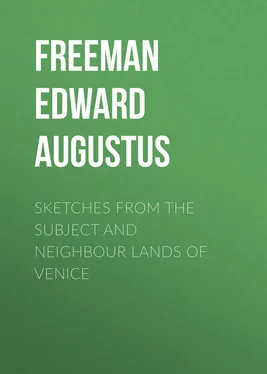Edward Freeman - Sketches from the Subject and Neighbour Lands of Venice
Здесь есть возможность читать онлайн «Edward Freeman - Sketches from the Subject and Neighbour Lands of Venice» — ознакомительный отрывок электронной книги совершенно бесплатно, а после прочтения отрывка купить полную версию. В некоторых случаях можно слушать аудио, скачать через торрент в формате fb2 и присутствует краткое содержание. Жанр: foreign_antique, foreign_prose, Путешествия и география, на английском языке. Описание произведения, (предисловие) а так же отзывы посетителей доступны на портале библиотеки ЛибКат.
- Название:Sketches from the Subject and Neighbour Lands of Venice
- Автор:
- Жанр:
- Год:неизвестен
- ISBN:нет данных
- Рейтинг книги:3 / 5. Голосов: 1
-
Избранное:Добавить в избранное
- Отзывы:
-
Ваша оценка:
- 60
- 1
- 2
- 3
- 4
- 5
Sketches from the Subject and Neighbour Lands of Venice: краткое содержание, описание и аннотация
Предлагаем к чтению аннотацию, описание, краткое содержание или предисловие (зависит от того, что написал сам автор книги «Sketches from the Subject and Neighbour Lands of Venice»). Если вы не нашли необходимую информацию о книге — напишите в комментариях, мы постараемся отыскать её.
Sketches from the Subject and Neighbour Lands of Venice — читать онлайн ознакомительный отрывок
Ниже представлен текст книги, разбитый по страницам. Система сохранения места последней прочитанной страницы, позволяет с удобством читать онлайн бесплатно книгу «Sketches from the Subject and Neighbour Lands of Venice», без необходимости каждый раз заново искать на чём Вы остановились. Поставьте закладку, и сможете в любой момент перейти на страницу, на которой закончили чтение.
Интервал:
Закладка:
Treviso, so near a neighbour of Venice, the earliest of her subject cities of the mainland, does not fail to proclaim the relation between the subject and the ruling commonwealth in the usual fashion. The winged lion, the ensign which we are to follow along so many shores, appears on not a few points of her defences. Over the gate of Saint Thomas the badge of the Evangelist appears in special size and majesty, accompanied, it would seem, by several younger members of his family whose wings have not yet had time to grow. And Treviso too in some sort calls up the memory of its mistress in the abundance of streams, canals, and bridges. It has at least more right than some of the towns to which the guide-books give the name, to be called a little Venice. But the contrast is indeed great between the still waters of the lagoons and the rushing torrents which pass under the walls and turn the mills of Treviso. Venice, in short, though her name has been rather freely scattered about hither and thither, remains without likeness or miniature among either subjects, rivals, or strangers.
The heart of an Italian city is to be looked for in its town-house and the open space before it. It is characteristic of the mistress of Treviso that her palace, the palace of her rulers, not of her people, stands somewhat aside from the great centre of Venetian life. The church of the patron saint who had become identified with the commonwealth takes in some sort the place which in more democratic states belongs to the home of the commonwealth itself. Technically indeed Saint Mark's is itself part of the palace; it answers to Saint Stephen's at Westminster, not to Saint Peter's; but nowhere else among commonwealths does the chapel of the palace in this sort surpass or rival the palace itself. The less famous Saint Liberalis, patron of the city and diocese of Tarvisium, does not venture, after the manner of the Evangelist, thus to supplant Tarvisium itself. The commonwealth fully proclaims its being in the group of municipal buildings which surround the irregular space which forms the municipal centre of the city. One alone of these, at once in some sort the oldest and the newest, calls for special notice. The former palazzo della Signoria , now the palace, the centre, in the new arrangement of things, not only of the city of Treviso but of the whole province of which it is the head, has been clearly renewed, perhaps rebuilt. But it keeps the true character of a Lombard building of the kind, the simpler and truer forms which were in vogue before the Venetian Gothic set in. It marks the true position of that style that, though we cannot help admiring many of its buildings when we look at them, we find it a relief when we come to something earlier and more real. The buildings of which Venice set the type are very rich, very elegant; but we feel that, after all, England, France, Germany, could all do better in the way of windows, and that Italy left to herself could do better in the way of columns and arches. Old or new, rebuilt or simply repaired, there is nothing very wonderful in the municipal palace of Treviso; but in either case it is pleasing as an example of the genuine native style of Italy. It has arcades below, groups of round-headed windows above, and the tower looks over the palace with the more effect, because it is not parallel to it. The arcades of the palace, continued in the form of the arcades of the streets, are a feature of Treviso, as of all other southern cities that were built by rational men in rational times, and were designed, unlike Venice and Curzola, for the passage of carriages and horses. At Treviso we have arcades of all kinds, all shapes, all dates, some rude enough, some really elegant, but all of them better than the portentous folly which has offered up modern Rome and modern Athens as helpless victims to whatever powers may be conceived to preside over heat, dust, and their consequences. Treviso is not a first-class Italian city; it is hardly one of the second class; but it is pleasant to thread one's way through the arcades, to try to spell out the geography of the streams that are crossed by many bridges; it is pleasant to mount here and there on the wall, to look down on the broad foss below, and across it on the rich plain with its wall of mountains in the distance.
In the ecclesiastical department what there is of any value above ground belongs mainly to the friars. The interest of the duomo , as a building, lies wholly in its crypt, a grand and spacious one, certainly not later than the twelfth century. It may be that some of the smaller marble shafts which support its vault had already done duty in some earlier building, and there is no doubt as to the classical date of a fragment of a large fluted column which in this same crypt serves the purpose of a well. The church above has been mercilessly Jesuited; yet, as it keeps more than one cupola, those cupolas give it a certain dignity; the stamp of Constantinople and Venice, of Périgueux and Angoulême, is hard wholly to wipe out. Otherwise a few tombs and a fine piece of mediæval gilded wood-carving are about all that the church of Treviso has to show. The great Dominican church has been more lucky. The guide-book of Gsel-fels, commonly the best of guide-books, but which cuts Treviso a little short, rather sets one against it by saying that it has been wholly modernized within. Repaired and freshened up it certainly has been; but it can hardly be said to have been modernized; the old lines seem not to have been tampered with. And there is something far from lacking in dignity in the effect of its vast interior, even though its style be the corrupt Gothic of Italy. One merit is that the arches which spring from the huge pillars, though wide, are not sprawling – not like those which those who do not dare to think for themselves are called on to admire in the nave of the Florentine duomo . Unlike the work of Arnolfo, the Dominican church of Treviso does not look one inch shorter or lower than it is. It has too the interest of much contemporary painting and other ornamental work. The smaller Benedictine church hard by, whose bell-tower groups so well with Saint Nicolas, employs in that bell-tower a trefoil arch, a strange form to spring from mid-wall shafts. Within there is not much to look at, beyond a tablet setting forth the glories of the Benedictine order, how many emperors, empresses, kings, queens, popes, cardinals, archbishops, bishops, and so forth, belonged to it. Dukes, marquesses, counts, and knights, were unnumbered. It is a strange thought that to that countless band Bec added the full manhood and long monastic life of Herlwin, that Saint Peter of Shrewsbury and Saint Werburh of Chester had severally the privilege of enrolling Earl Roger and Earl Hugh, each for a few days only, as members of the brotherhood of Benedict and Anselm.
The other friars' church, that of Saint Francis, has been less lucky than its Dominican rival. Desecrated and partitioned, its inside is now inaccessible; the outside promises well for a church of its own type. Yet how feeble after all are the very best of these Italian buildings which forsook their own native forms for a hopeless attempt to reproduce the forms of other lands. We are always told that Italian Gothic cannot be Northern Gothic, because Italy is not like Northern lands. True enough; but what that argument proves is that Italy should have kept to her own natural Romanesque, the true fruit of her own soil, and should never have meddled with forms which could not be transplanted in their purity. The great fact of Italian architectural history is that the native style never was thoroughly driven out, but that, alongside of the sham Gothic, true Romanesque lived on to lose itself in the earlier and better kind of Renaissance . The open arcades of streets and houses, and the bell-towers of the churches, largely remain really Romanesque in style at all dates. For the working out of the same law in greater buildings we must make our way south-eastward. The chronicler of the eleventh century hinted that Treviso was near to Venice, and the men of the fourteenth century acted on the hint. But the wise Doge, who a generation later told his people to stick to the sea and leave the land behind, knew better where the true subject and neighbour lands of Venice lay. We cannot fully obey him as yet, as we have still points on the Italian mainland to visit. But we may still keep the true goal of our pilgrimage before our eyes, and we may remember that the lands which were most truly near to Venice were those lands, subject and hostile, to which the path lay by her own element. The lessons of which we begin to get a glimpse at Treviso we shall not learn in their fulness till we have reached the other side of Hadria.
Читать дальшеИнтервал:
Закладка:
Похожие книги на «Sketches from the Subject and Neighbour Lands of Venice»
Представляем Вашему вниманию похожие книги на «Sketches from the Subject and Neighbour Lands of Venice» списком для выбора. Мы отобрали схожую по названию и смыслу литературу в надежде предоставить читателям больше вариантов отыскать новые, интересные, ещё непрочитанные произведения.
Обсуждение, отзывы о книге «Sketches from the Subject and Neighbour Lands of Venice» и просто собственные мнения читателей. Оставьте ваши комментарии, напишите, что Вы думаете о произведении, его смысле или главных героях. Укажите что конкретно понравилось, а что нет, и почему Вы так считаете.












